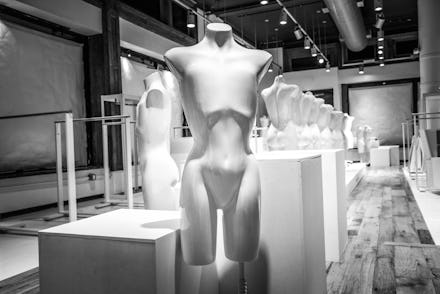How this NYC boutique is revolutionizing the mannequin

For Rob Smith, the founder of the Phluid Project, the New York City-based boutique believed to be one of the first gender-fluid stores in the world, everything was critical. It was critical that he stock a variety of clothes that would look good on any body. It was critical that he stock brands that are run by women and members of LGBTQ communities. It was critical that the store feel safe and his employees be trained to make everyone walking through the doors feel comfortable.
And it was important for the mannequins, on which his fashions are displayed, to not be one particular gender.
Finding this was harder than he thought.
“This was maybe the most critical decision in the store,” Smith said in a recent interview. “I went through as many catalogues as I could find, and every accessible catalogue I went through, it was impossible to find a mannequin that was gender-free.”
That’s because they don’t exist. Mannequins, which go for hundreds of dollars, are always either distinctly male or female, with male mannequins featuring broad shoulders, broad chests and narrow hips, and female mannequins often featuring a larger bust, a nipped waist and wider hips. In truth, they’re often a good study of what society sees as the ideal male and female body type.
And though gender-free shopping spaces have existed before this, in retailers like Selfridges in the U.K., they’ve often just simply removed all the mannequins from these areas.
Smith wouldn’t accept that workaround, and instead set out on a quest to design his own mannequins that were not immediately discernible as male or female, but a mix. The result is the first gender-free mannequin.
“I looked at the female mannequins and found one that was for intimate apparel,” Smith said. “It had a decent waist and a nice butt and what I did was alter the breast to make them nonexistent in a way, and narrow the hips just a tiny bit. It didn’t come across as male or female. It just wore clothes very well.”
There has been some experimentation with the gendered state of mannequins before. In 2015, the mannequin company Rootstein teamed up with Phillipe Blond, one of the designers behind the label the Blonds, and used his body as a model for both male and female mannequins as a way to blur the gender divide.
The designers at the label are particularly thrilled with Smith’s new development.
“This is amazing!” the Blonds said in an email. “We are so thrilled to see society moving forward in this direction. With the Blonds Phillipe Mannequins by Rootstein, we strived to push the gender envelope, and Phluid’s gender-free mannequins are exciting to see. We hope more stores follow suit!”
Smith firmly believes that if we want more gender-free shopping spaces, then these kinds of gender-free mannequins are essential.
“I think it’s the cart before the horse,” Smith said. “We’re the first gender-free store, so if more people started to open stores like us, or departments, there would definitely be a need for these mannequins. I hope the industry would be in touch with that.”
What the mannequins have been able to create, too, is another layer to Phluid, by defining it as a space that is safe and created with members of LGBTQ and gender nonconforming communities in mind.
“I feel empowered working with gender-free mannequins and within a space that’s not defined by gendered lifestyles,” Frankie Martinez, the Phluid Project’s visual manager, said in an email. “They’re gorgeous, both because of their physicality and because of what and whom they represent.”